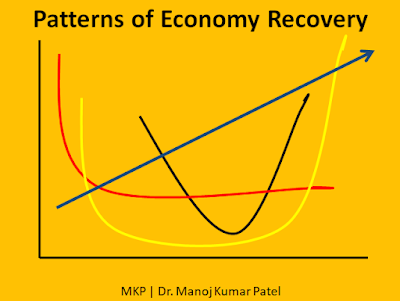Economic Recovery post-covid19: a Layman’s Viewpoints
Economic Recovery post-covid19: a Layman’s Viewpoints : Dr. Manoj Kumar Patel : Economy and Economics: An economy encompasses all activity related to production, consumption, and trade of goods and services in an area. An economy applies to everyone from individuals to entities such as corporations and governments. A region's economy is connected with things like how many goods and services are produced and how much money people can spend on these things. The economy is measured by the Gross Domestic Product or GDP. When the GDP growth rate turns negative, the economy enters a recession. The most important part of the economy is consumer spending. So, as a rule of thumb, more the transactions and spending by the consumers better is the economy of that country. Thus money should be available in the hands of the consumers. The other three components are business expenditures, government spending, and net e...





Very convincing argument.
ReplyDeleteCould be the reason. I have a few questions.
1. What about the packaging?
2. Would there not have been gaps between lots?
3. Will not ammonium nitrate disintegrate over time?
4. Is it hygroscopic?
Thanks for your comments.
DeleteComing over to the points, (a) the packages (poly liners) are the fuels, that facilitates the redox reaction, (b) gaps in the lots mean availability of air (oxygen). This further acts as sensitizer, (c) AN does not disintegrate easily because it is a very stable salt, and (d) Yes it is hygroscopic in nature.
So would it not have become soggy over the years or did the poly liners prevent moisture?
ReplyDeleteThis comment has been removed by the author.
DeleteThere is no doubt that poly liners prevent absorption of moisture. But here we are speaking about the role of poly liners (low density LDPE, as well as high density HDPE poly ethylene) when a fire has erupted in the AN store house.
DeletePresence of LDPE and HDPE in thin liner forms facilitate to form a sort of oxidizer-fuel mixture that can burn faster and also detonate (we may imagine likes of ANFO).
When a fire take place various parameters in and around often adds to the spread of the fire. Just like, nylon clothing may be comfortable to wear but on coming in contact with flame it gives rise to severe burns as compared to cotton clothes.
I hope I am clear in clarifying the doubts.
Nicely explained about Beirut incident .You have clarified all the doubts about the storing and using of ammonium nitrate and its effect if it will remain unused for a long period of time .
ReplyDelete